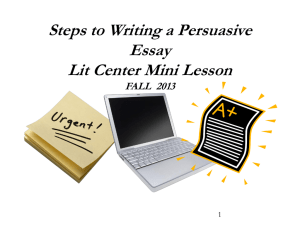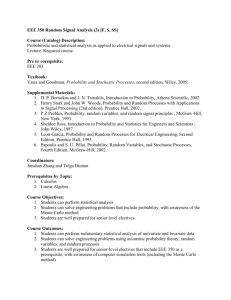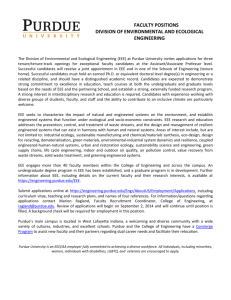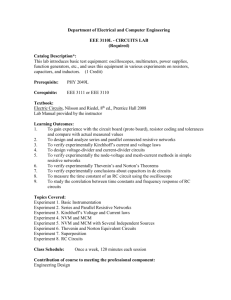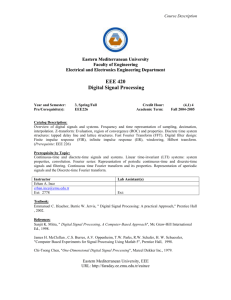Socio-Emotional
advertisement
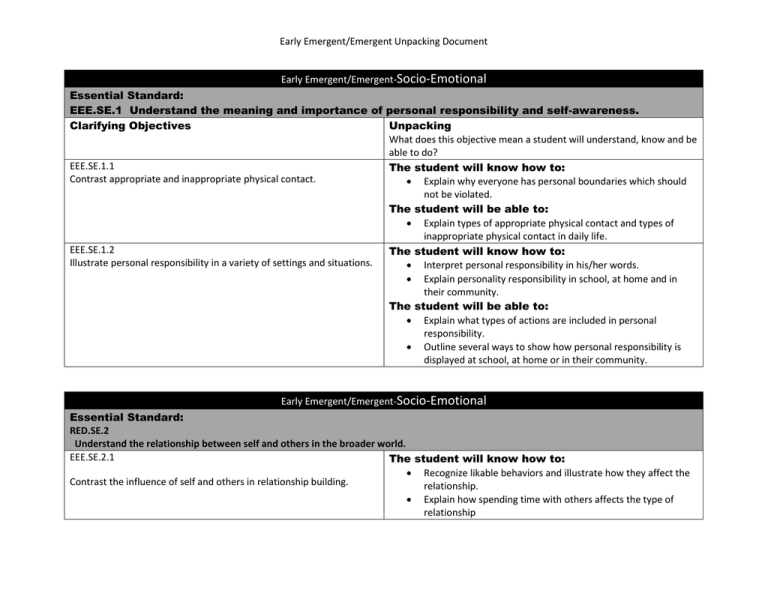
Early Emergent/Emergent Unpacking Document Early Emergent/Emergent-Socio-Emotional Essential Standard: EEE.SE.1 Understand the meaning and importance of personal responsibility and self-awareness. Clarifying Objectives Unpacking What does this objective mean a student will understand, know and be able to do? EEE.SE.1.1 The student will know how to: Contrast appropriate and inappropriate physical contact. Explain why everyone has personal boundaries which should not be violated. The student will be able to: Explain types of appropriate physical contact and types of inappropriate physical contact in daily life. EEE.SE.1.2 The student will know how to: Illustrate personal responsibility in a variety of settings and situations. Interpret personal responsibility in his/her words. Explain personality responsibility in school, at home and in their community. The student will be able to: Explain what types of actions are included in personal responsibility. Outline several ways to show how personal responsibility is displayed at school, at home or in their community. Early Emergent/Emergent-Socio-Emotional Essential Standard: RED.SE.2 Understand the relationship between self and others in the broader world. EEE.SE.2.1 The student will know how to: Recognize likable behaviors and illustrate how they affect the Contrast the influence of self and others in relationship building. relationship. Explain how spending time with others affects the type of relationship Early Emergent/Emergent Unpacking Document EEE.SE.2.2 Explain why it is important to follow rules in order to build relationships. EEE.SE.2.3 Explain why responsibility, dependability, punctuality, integrity, and effort are important in all aspects of life. The student will be able to: Classify traits they like in friends. Explain what makes a person a friend as opposed to just a classmate or acquaintance. The student will know how to: Tell why rules are important. Tell how following rules help people get along with each other. The student will be able to: Paraphrase the rules in various environments (school, home, community, etc.). Explain how following rules helps build relationships with their friends and/or family. The student will know how to: Show the relationship between responsibility, punctuality, integrity and effort. The student will be able to: Summarize traits of responsibility, dependability, punctuality, integrity and effort. Illustrate the effects of responsibility, dependability, punctuality, integrity and effort on the various aspects of the student’s life. (home, school, friendships, etc) Early Emergent/Emergent-Socio-Emotional EEE.SE.3 Use communication strategies effectively for a variety of purposes and audiences. EEE.SE.3.1 The student will know how to: Vary communications (e.g. written, oral, non-verbal) that are Use written communication strategies and techniques in appropriate for targeted audiences. communication to share ideas and information with others. The student will be able to: Compare various ways to communicate the same message. Early Emergent/Emergent Unpacking Document EEE.SE.3.2 Summarize written communications in order to concisely share ideas and information with others. The student will know how to: Interpret and summarize forms of communication. The student will be able to: Paraphrase a variety of information communicated to him/her. Explain and share information given to them by a teacher. Early Emergent/Emergent-Cognitive Essential Standard: EEE.C.1 Use creative strategies to solve problems. EEE.C.1.1 Create strategies for solving problems that have been problems for some time. EEE.C.1.2 Use creative strategies to achieve academic, personal, social, and professional goals. Essential Standard: EEE.C.2 Use analytical strategies to understand situations. EEE.C.2.1 Analyze problems in terms of the academic, social, personal, and career information needed to solve them. The student will know how to: Select strategies for solving recurring problems. The student will be able to: Explain strategies based on a problem-solving model. Compare what worked and did not work with previous strategies The student will know how to: Understand a goal-setting model Use creative strategies to set goals. The student will be able to: Explain strategies based on a goal-setting model (academic, personal, social, and professional). Describe the steps of a goal-setting model Explain the benefits of setting goals The student will know how to: Illustrate an academic, social and personal problem Infer how a problem in one area can extend into other areas. Early Emergent/Emergent Unpacking Document The student will be able to: Read a given narrative, identify facts or ideas that illustrate a possible problem, determine impact on academic, social, personal or career areas. EEE.C.2.2 Apply critical thinking skills systematically to solve problems and make decisions. EEE.C.2.3 Predict the consequences of applying analytic strategies in terms of whether they are likely to be positive or negative. The student will know how to: Summarize the meaning of critical thinking. Use critical thinking skills in a problem solving model to make decisions. The student will be able to: Summarize the various traits and skills used in critical thinking. Read a given narrative, explain the problem presented, and use critical thinking skills to solve this problem. The student will know how to: Identify and understand positive and negative outcomes. Identify a strategic plan. The student will be able to: Outline the steps of a strategic plan for completing an assignment/project. Explain effects of strategic planning on the outcome of the assignment/project. Early Emergent/Emergent-Career Essential Standard: EEE.CR.1 Understand the meaning and importance of career self-awareness and career goals. EEE.CR.1.1 The student will know how to: Explain what career planning is and what is included in a career Explain the importance of planning in career success. plan. Summarize how planning can affect an outcome and relate career planning to possible career success. Early Emergent/Emergent Unpacking Document The student will be able to: Give examples of the components of a career plan Summarize how planning may affect an outcome Discuss the relationship of planning to career success. Essential Standard: EEE.CR.2 Understand the relationship among career goals and interests, personal interests, aptitudes, and abilities. EEE. CR.2.1 The student will know how to: Discover his/her personal preferences and interests Match personal preferences and interests to careers in which Identify personal preferences and interests that influence career people with similar preferences and interests succeed. choice and success. The student will be able to: Explain his/her personal preferences and interests Compare his/her personal preferences and interests to careers EEE.CR.2.2 The student will know how to: Predict how personal preferences and interests influence Exemplify (give examples of) how personal preferences and interests career choices and success. influence career choice and success. The student will be able to: Discover potential top career choices based upon personal preferences and interest. Infer how personal preferences and interests relate to career choices. Essential Standard: EEE.CR.3 Understand the relationship among personal and academic decisions, career expectations, and future life decisions. EEE. CR.3.1 The student will know how to: Understand the different levels of educational achievement Understand the relationship between educational achievement and and the influence on possible career success. career success. The student will be able to: Explain the different levels of educational achievement. Examine how educational achievement situations affect career opportunities. Early Emergent/Emergent Unpacking Document EEE.CR.3.2 Exemplify (give examples of) how educational achievement influences career success. The student will know how to: Compare how educational achievement may influence career success. The student will be able to: Give examples of how the different levels of educational achievement may impact possible career opportunities and affect future success. Essential Standard: EEE.CR.4 Understand the connection among attendance, collaboration, course selection, grades, grade point average, undergraduate admission, career expectations, and life goals. EEE.CR.4.1 The student will know how to: Explain what working cooperatively means and how varying Explain how working cooperatively with others as a team member can levels of cooperation are needed for different occupations. influence career choices and success. The student will be able to: Explain the behaviors necessary for cooperation and teamwork. Explain why cooperation and teamwork are part of any career. List careers where a high level of cooperation and teamwork are essential. EEE.CR.4.2 The student will know how to: Explain the relationship between attendance, school grades, Explain how attendance, school grades, and GPA are possible GPA, and career success. indicators of future academic and career success. The student will be able to: Predict how attendance, school grades and GPA influence future career choices and success in those career choices. Infer the different messages that future college admission teams and employers receive by reviewing his/her school attendance, grades and GPA.

